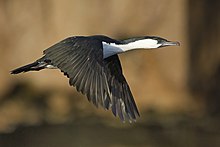Black Face Scrap
| Black Face Scrap | ||||||||||||
|---|---|---|---|---|---|---|---|---|---|---|---|---|

Black-faced cormorant ( Phalacrocorax fuscescens ) |
||||||||||||
| Systematics | ||||||||||||
|
||||||||||||
| Scientific name | ||||||||||||
| Phalacrocorax fuscescens | ||||||||||||
| ( Vieillot , 1817) |
The black- faced shag ( Phalacrocorax fuscescens ) is a species of bird in the genus Phalacrocorax within the cormorant family . The species colonizes the coasts of southern Australia and Tasmania . It breeds in colonies and feeds primarily on fish . The IUCN leads the kind as " not endangered (least concern) ". The black-faced pint is still hunted regularly in Australia.
Appearance
Black face scars reach a head-torso length of 61 to 69 centimeters, about half of which is on the body. The wingspan is between 93 and 107 centimeters. The species shows a slight sexual dimorphism , the males are slightly larger and heavier than the females.
Outwardly, the species is very similar to the closely related, somewhat larger magpie , it only has slightly more black feathers on the flanks. The beak is dark gray, the featherless skin of the face, which extends from the base of the beak to the eye, is black. The iris is dark blue in color, legs and feet are dark gray. During the breeding season , adult birds have some narrow, white feathers in the otherwise black plumage of the back, neck and flanks. In plumage these white feathers are missing.
Young birds are already very similar to adult birds, but the black plumage areas of adult birds are dark brown in color in young birds. The beak is still gray in young birds. The throat pouch is pink, while the featherless skin on the face is gray.
On land the black-faced scar moves with quick steps. The posture is upright, the feet are raised relatively sharply. In flight, the head and neck are stretched far forward, the head is held below the line that forms the axis of the body.
There are also possibilities of confusion between the magpie and the white-throated color morph of the Australian dwarf . This is smaller than the Black Face Scar, built somewhat more compactly and has a shorter, yellowish bill and longer control feathers. In contrast to the black face pod, the face is feathered white up to the eyes.
distribution and habitat
Black- faced shags are common on the south coast of Australia and around Tasmania , where they mainly inhabit shallow coastal waters. They live mainly marine, estuaries and larger lakes near the coast are rarely visited. There are two distinct populations: one in south-west Australia and one in south-east Australia and Tasmania.
The species is a resident bird , only after the breeding season there is dismigration of young birds over short distances.
food
The main component of the diet are fish , especially perch . A small percentage of the diet consists of invertebrates such as crabs and mussels . Like all cormorants, the species prefers to hunt its prey by diving, following and catching it while swimming underwater. Since the plumage of the black-faced pint absorbs water, it has to be dried after a dive. Like most cormorants, the species spreads its wings and lets the sun or wind dry its plumage.
Breeding behavior
Blackface pods enter into a monogamous couple relationship that may last for more than one reproductive period. The breeding season usually begins in spring, but it is largely influenced by the nutritional situation. But broods have already been observed between July and January.
The species breeds in colonies of up to 2000 breeding pairs on cliffs, ledges and steep slopes, often among other seabirds. The nest consists mainly of sticks, algae and grass and is padded with feathers. It is solidified with excrement . Usually 2 or 3 eggs are laid. The initially naked chicks hatch after an incubation period of 25 to 30 days. After a few days , the chicks grow into a down dress that is brown on the back and white on the belly. The young birds fledge about 60 days after hatching.
Systematics
As with all cormorants, the exact systematic position of the species is disputed. Some scientists place the species in the genus Leucocarbo , but this view is not widely accepted. No subspecies are distinguished.
Hazard and protection
The IUCN lists the species as not endangered (least concern) , as the species is not threatened by overfishing of its prey fish and its habitat is only marginally affected by human influences.
supporting documents
literature
- Josep del Hoyo , Andrew Elliot, Jordi Sargatal : Handbook of the birds of the world. Volume 1: Ostrich to Ducks. Lynx Edicions, Barcelona 1992, ISBN 84-87334-10-5 .
- PJ Higgins (Ed.): Handbook of Australian, New Zealand & Antarctic Birds. Volume 1: Ratites to Ducks. Oxford University Press, Oxford 1990, ISBN 0-19-553068-3 .
Individual evidence
- ↑ Phalacrocorax fuscescens in the endangered Red List species the IUCN 2010. Posted by: BirdLife International, 2009. Accessed March 16, 2011th
- ↑ a b Higgins, p. 898
- ↑ a b c Higgins, p. 897

